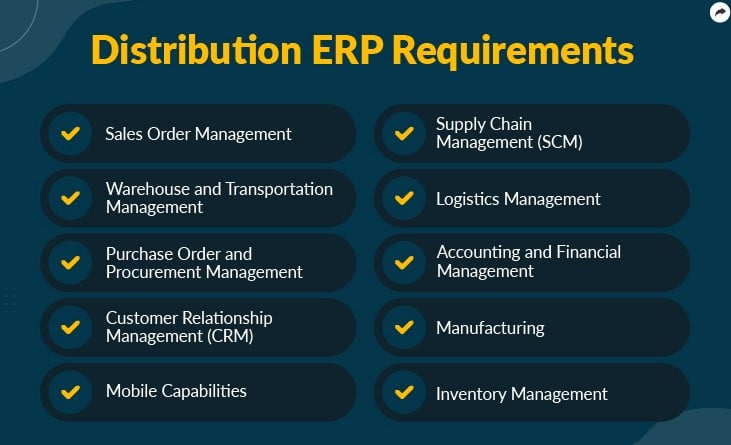In the intricate dance of supply chain management, Distribution ERP emerges as a key player. This article delves into the world of Distribution ERP, exploring its definition, evolution, key features, benefits, challenges, successful implementations, future trends, and insights on selecting the right system. Join the journey of how ERP transforms the distribution landscape.
Evolution of Distribution ERP

The story of Distribution is intertwined with the evolution of supply chain solutions. From manual processes to the integration of ERP systems, the sector has witnessed a paradigm shift. Distribution stands at the forefront, revolutionizing how businesses manage and optimize their supply chains.
Key Features of Distribution ERP
Inventory Management
Distribution ERP excels in inventory management, providing businesses with a centralized system for tracking and managing stock levels. This feature ensures that businesses can meet customer demands while minimizing excess inventory costs.
Order Processing
Efficient order processing is a hallmark of ERP. The system automates order fulfillment processes, reducing processing times and minimizing errors. This not only enhances customer satisfaction but also streamlines overall operations.
Logistics Optimization
Logistics plays a crucial role in distribution. Distribution optimizes logistics by providing real-time visibility into shipments, route planning, and delivery tracking. Businesses can make informed decisions to ensure timely and cost-effective deliveries.
Benefits of Implementing Distribution ERP
Enhanced Efficiency
Distribution enhances operational efficiency by automating routine tasks and providing real-time insights. This efficiency translates into quicker order processing, reduced lead times, and improved overall productivity.
Real-time Visibility
Real-time visibility is a game-changer in distribution. ERP offers a bird’s-eye view of the entire supply chain, from warehouse stock levels to in-transit shipments. Businesses gain actionable insights to make informed decisions.
Cost Reduction
Cost reduction is a significant benefit of Distribution. By optimizing inventory, streamlining operations, and minimizing errors, businesses can achieve substantial cost savings in their distribution processes.
Challenges in Implementing Distribution ERP
Integration Complexities
Integrating Distribution with existing systems can be complex. Businesses often grapple with the challenge of ensuring seamless integration without disrupting ongoing operations. Strategic planning and collaboration with ERP specialists are essential.
Data Security Concerns
ERP involves the handling of sensitive data. Ensuring data security is a priority. Businesses need robust security measures to protect customer information, financial data, and other critical details.
User Training
Adopting new systems requires thorough user training. Distribution ERP’s advanced features may necessitate a learning curve. Well-structured training programs and ongoing support are crucial for successful adoption.
Case Studies: Successful Distribution ERP Implementations
Company A: Streamlining Warehouse Operations
By implementing Distribution , Company A achieved a 20% reduction in warehouse processing times. The system’s real-time visibility and automated workflows significantly improved overall efficiency.
Company B: Improving Order Accuracy
Struggling with order accuracy issues, Company B adopted ERP, resulting in a 30% reduction in order errors. The system’s order processing features contributed to enhanced customer satisfaction.
Future Trends in Distribution ERP
IoT Integration
The future of Distribution lies in the integration of the Internet of Things (IoT). IoT sensors and devices will provide real-time data on inventory levels, equipment status, and shipment conditions, further optimizing distribution processes.
Blockchain in Supply Chain
Blockchain technology is making inroads into supply chain management. Distribution is expected to leverage blockchain for enhanced transparency, traceability, and security in the distribution network.
Selecting the Right Distribution ERP System
Scalability
Choosing a scalable ERP system is vital. Businesses need a system that can grow with their evolving needs, accommodating increased transaction volumes and expanding distribution networks.
Integration Capabilities
The ability to seamlessly integrate with existing systems is a crucial factor in selecting a ERP system. Compatibility with other business software ensures a cohesive and efficient operation.
Realizing the Full Potential of Distribution ERP
User Adoption Strategies
Success with Distribution ERP hinges on user adoption. Businesses should implement comprehensive training programs, making employees comfortable with the system’s functionalities and encouraging its use.
Continuous Improvement
Distribution ERP is not a static solution but a dynamic process. Businesses should adopt continuous improvement strategies, incorporating user feedback and staying updated on technological advancements to maximize the benefits of the system.
Conclusion
In conclusion, ERP is the linchpin in the modern distribution landscape. Its impact on efficiency, visibility, and cost reduction is undeniable. As businesses navigate the complexities of supply chain management, embracing Distribution becomes not just a choice but a strategic imperative for those aiming to thrive in the competitive distribution arena.